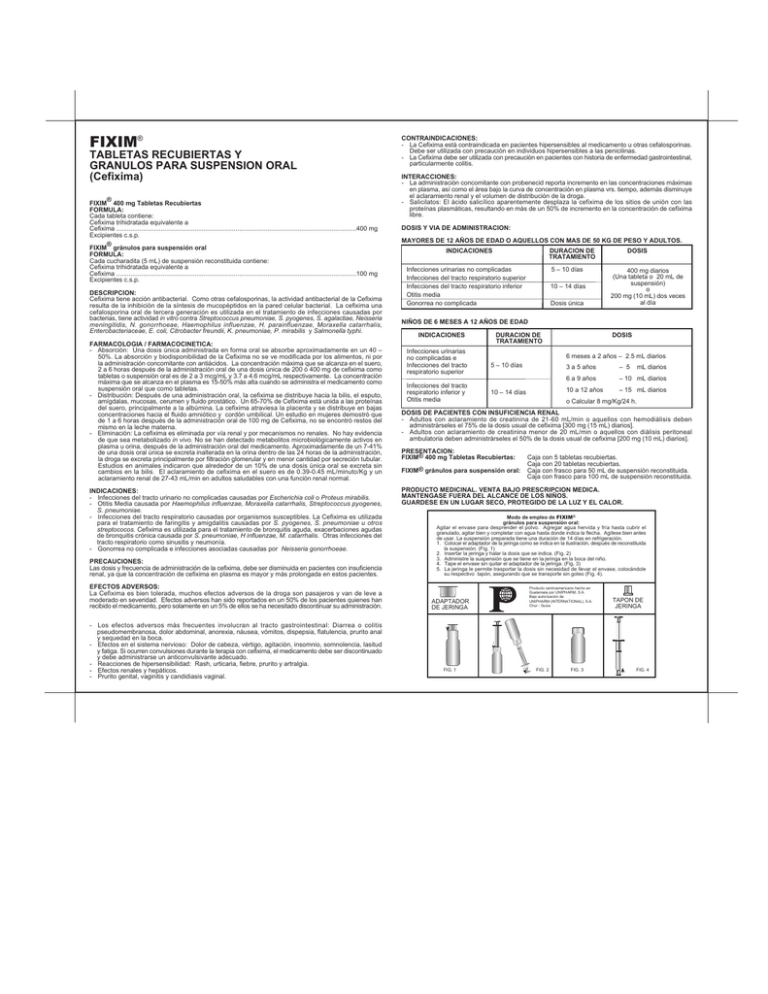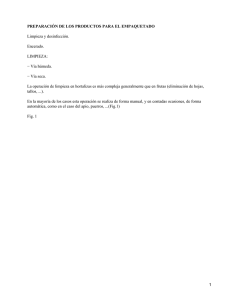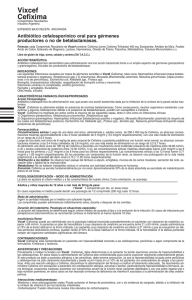FIXIM TABLETAS RECUBIERTAS Y GRANULOS PARA SUSPENSION ORAL (Cefixima)
Anuncio

FIXIM® TABLETAS RECUBIERTAS Y GRANULOS PARA SUSPENSION ORAL (Cefixima) ® FIXIM 400 mg Tabletas Recubiertas FORMULA: Cada tableta contiene: Cefixima trihidratada equivalente a Cefixima .......................................................................................................................................400 mg Excipientes c.s.p. ® FIXIM gránulos para suspensión oral FORMULA: Cada cucharadita (5 mL) de suspensión reconstituida contiene: Cefixima trihidratada equivalente a Cefixima .......................................................................................................................................100 mg Excipientes c.s.p. DESCRIPCION: Cefixima tiene acción antibacterial. Como otras cefalosporinas, la actividad antibacterial de la Cefixima resulta de la inhibición de la síntesis de mucopéptidos en la pared celular bacterial. La cefixima una cefalosporina oral de tercera generación es utilizada en el tratamiento de infecciones causadas por bacterias, tiene actividad in vitro contra Streptococcus pneumoniae, S. pyogenes, S. agalactiae, Neisseria meningitidis, N. gonorrhoeae, Haemophilus influenzae, H. parainfluenzae, Moraxella catarrhalis, Enterobacteriaceae, E. coli, Citrobacter freundii, K. pneumoniae, P. mirabilis y Salmonella typhi. FARMACOLOGIA / FARMACOCINETICA: - Absorción: Una dosis única administrada en forma oral se absorbe aproximadamente en un 40 – 50%. La absorción y biodisponibilidad de la Cefixima no se ve modificada por los alimentos, ni por la administración concomitante con antiácidos. La concentración máxima que se alcanza en el suero, 2 a 6 horas después de la administración oral de una dosis única de 200 ó 400 mg de cefixima como tabletas o suspensión oral es de 2 a 3 mcg/mL y 3.7 a 4.6 mcg/mL respectivamente. La concentración máxima que se alcanza en el plasma es 15-50% más alta cuando se administra el medicamento como suspensión oral que como tabletas. - Distribución: Después de una administración oral, la cefixima se distribuye hacia la bilis, el esputo, amígdalas, mucosas, cerumen y fluido prostático. Un 65-70% de Cefixima está unida a las proteínas del suero, principalmente a la albúmina. La cefixima atraviesa la placenta y se distribuye en bajas concentraciones hacia el fluido amniótico y cordón umbilical. Un estudio en mujeres demostró que de 1 a 6 horas después de la administración oral de 100 mg de Cefixima, no se encontró restos del mismo en la leche materna. - Eliminación: La cefixima es eliminada por vía renal y por mecanismos no renales. No hay evidencia de que sea metabolizado in vivo. No se han detectado metabolitos microbiológicamente activos en plasma u orina, después de la administración oral del medicamento. Aproximadamente de un 7-41% de una dosis oral única se excreta inalterada en la orina dentro de las 24 horas de la administración, la droga se excreta principalmente por filtración glomerular y en menor cantidad por secreción tubular. Estudios en animales indicaron que alrededor de un 10% de una dosis única oral se excreta sin cambios en la bilis. El aclaramiento de cefixima en el suero es de 0.39-0.45 mL/minuto/Kg y un aclaramiento renal de 27-43 mL/min en adultos saludables con una función renal normal. INDICACIONES: - Infecciones del tracto urinario no complicadas causadas por Escherichia coli o Proteus mirabilis. - Otitis Media causada por Haemophilus influenzae, Moraxella catarrhalis, Streptococcus pyogenes, S. pneumoniae. - Infecciones del tracto respiratorio causadas por organismos susceptibles. La Cefixima es utilizada para el tratamiento de faringitis y amigdalitis causadas por S. pyogenes, S. pneumoniae u otros streptococos. Cefixima es utilizada para el tratamiento de bronquitis aguda, exacerbaciones agudas de bronquitis crónica causada por S. pneumoniae, H influenzae, M. catarrhalis. Otras infecciones del tracto respiratorio como sinusitis y neumonía. - Gonorrea no complicada e infecciones asociadas causadas por Neisseria gonorrhoeae. PRECAUCIONES: Las dosis y frecuencia de administración de la cefixima, debe ser disminuida en pacientes con insuficiencia renal, ya que la concentración de cefixima en plasma es mayor y más prolongada en estos pacientes. EFECTOS ADVERSOS: La Cefixima es bien tolerada, muchos efectos adversos de la droga son pasajeros y van de leve a moderado en severidad. Efectos adversos han sido reportados en un 50% de los pacientes quienes han recibido el medicamento, pero solamente en un 5% de ellos se ha necesitado discontinuar su administración. - Los efectos adversos más frecuentes involucran al tracto gastrointestinal: Diarrea o colitis pseudomembranosa, dolor abdominal, anorexia, náusea, vómitos, dispepsia, flatulencia, prurito anal y sequedad en la boca. - Efectos en el sistema nervioso: Dolor de cabeza, vértigo, agitación, insomnio, somnolencia, lasitud y fatiga. Si ocurren convulsiones durante la terapia con cefixima, el medicamento debe ser discontinuado y debe administrarse un anticonvulsivante adecuado. - Reacciones de hipersensibilidad: Rash, urticaria, fiebre, prurito y artralgia. - Efectos renales y hepáticos. - Prurito genital, vaginitis y candidiasis vaginal. CONTRAINDICACIONES: - La Cefixima está contraindicada en pacientes hipersensibles al medicamento u otras cefalosporinas. Debe ser utilizada con precaución en individuos hipersensibles a las penicilinas. - La Cefixima debe ser utilizada con precaución en pacientes con historia de enfermedad gastrointestinal, particularmente colitis. INTERACCIONES: - La administración concomitante con probenecid reporta incremento en las concentraciones máximas en plasma, así como el área bajo la curva de concentración en plasma vrs. tiempo, además disminuye el aclaramiento renal y el volumen de distribución de la droga. - Salicilatos: El ácido salicílico aparentemente desplaza la cefixima de los sitios de unión con las proteínas plasmáticas, resultando en más de un 50% de incremento en la concentración de cefixima libre. DOSIS Y VIA DE ADMINISTRACION: MAYORES DE 12 AÑOS DE EDAD O AQUELLOS CON MAS DE 50 KG DE PESO Y ADULTOS. INDICACIONES DURACION DE TRATAMIENTO Infecciones urinarias no complicadas Infecciones del tracto respiratorio superior Infecciones del tracto respiratorio inferior Otitis media Gonorrea no complicada 5 – 10 días 10 – 14 días Dosis única DOSIS 400 mg diarios (Una tableta o 20 mL de suspensión) o 200 mg (10 mL) dos veces al día NIÑOS DE 6 MESES A 12 AÑOS DE EDAD INDICACIONES Infecciones urinarias no complicadas e Infecciones del tracto respiratorio superior Infecciones del tracto respiratorio inferior y Otitis media DURACION DE TRATAMIENTO DOSIS 6 meses a 2 años – 2.5 mL diarios 5 – 10 días 10 – 14 días 3 a 5 años – 5 6 a 9 años – 10 mL diarios mL diarios 10 a 12 años – 15 mL diarios o Calcular 8 mg/Kg/24 h. DOSIS DE PACIENTES CON INSUFICIENCIA RENAL - Adultos con aclaramiento de creatinina de 21-60 mL/min o aquellos con hemodiálisis deben administrárseles el 75% de la dosis usual de cefixima [300 mg (15 mL) diarios]. - Adultos con aclaramiento de creatinina menor de 20 mL/min o aquellos con diálisis peritoneal ambulatoria deben administrárseles el 50% de la dosis usual de cefixima [200 mg (10 mL) diarios]. PRESENTACION: FIXIM® 400 mg Tabletas Recubiertas: FIXIM® gránulos para suspensión oral: Caja con 5 tabletas recubiertas. Caja con 20 tabletas recubiertas. Caja con frasco para 50 mL de suspensión reconstituida. Caja con frasco para 100 mL de suspensión reconstituida. PRODUCTO MEDICINAL. VENTA BAJO PRESCRIPCION MEDICA. MANTENGASE FUERA DEL ALCANCE DE LOS NIÑOS. GUARDESE EN UN LUGAR SECO, PROTEGIDO DE LA LUZ Y EL CALOR. Modo de empleo de FIXIM® gránulos para suspensión oral: Agitar el envase para desprender el polvo. Agregar agua hervida y fría hasta cubrir el granulado, agitar bien y completar con agua hasta donde indica la flecha. Agítese bien antes de usar. La suspensión preparada tiene una duración de 14 días en refrigeración. 1. Colocar el adaptador de la jeringa como se indica en la ilustración, después de reconstituida la suspensión. (Fig. 1) 2. Insertar la jeringa y halar la dosis que se indica. (Fig. 2) 3. Administre la suspensión que se tiene en la jeringa en la boca del niño. 4. Tape el envase sin quitar el adaptador de la jeringa. (Fig. 3) 5. La jeringa le permite trasportar la dosis sin necesidad de llevar el envase, colocándole su respectivo tapón, asegurando que se transporte sin goteo (Fig. 4). ADAPTADOR DE JERINGA FIG. 1 Producto centroamericano hecho en Guatemala por UNIPHARM, S.A. Bajo autorización de UNIPHARM (INTERNATIONAL), S.A. Chur - Suiza FIG. 2 FIG. 3 TAPON DE JERINGA FIG. 4 FIXIM® Coated tablets and Granules for oral suspension (Cefixime) ® FIXIM 400 mg Coated Tablets Formula: Each tablet contains: Cefixime trihydrate equivalent to Cefixime..........................................................................................................................................400 mg Excipient q.s. ® FIXIM granules for oral suspension FORMULA: Each teaspoonful (5 mL) of reconstituted suspension contains: Cefixime trihydrate equivalent to Cefixime..........................................................................................................................................100 mg Excipient q.s. DESCRIPTION: Cefixime has antibacterial activity. As with other cephalosporins, Cefixime antibacterial activity results from inhibition of bacterial cell-wall mucopeptides synthesis. Cefixime is an oral third generation cephalosporin used for the treatment of infections caused by bacteria with in vitro activity against Streptococcus pneumoniae, S. pyogenes, S. agalactiae, Neisseria meningitidis, N. gonorrhoeae, Haemophilus influenzae, H. parainfluenzae, Moraxella catarrhalis, Enterobacteriaceae, E. coli, Citrobacter freundii, K. pneumoniae, P. Mirabilis and Salmonella typhi. PHARMACOLOGY / PHARMACOKINETICS: – Absorption: A single oral dose is approximately 40-50%absorbed. Cefixime absorption and bioavailability is not modified by foods, or concomitant administration of antacids. Peak serum concentration is reached 2 to 6 hours after oral administration of a 200 or 400 mg single dose of Cefixime as tablets or oral suspension is 2 to 3 mcg/mL and 3.7 to 4.6 mcg/mL, respectively. Average peak serum concentration is 15-50% higher when the drug is administered as oral suspension when compared to tablets. – Distribution: After the administration of an oral single dose, Cefixime is distributed to the bile, sputum, tonsils, mucous and prostatic fluids. About 65-70% of Cefixime is bound to serum proteins, mainly albumin. Cefixime crosses the placenta and it is distributed at low concentrations to the amniotic fluid and umbilical cord. A trial in women showed that after 1-6 hours after the oral administration of 100 mg of Cefixime did not yield traces of the drug in breast-milk. – Clearance: Cefixime is excreted through renal and non-renal mechanisms. There is no evidence of in vivo metabolism. No microbiologically active metabolites have been found in plasma and urine after the oral administration of the drug. About 7-41% of an oral single dose is excreted unchanged in the urine within 24 hours after its administration. The drug is mainly excreted by gromelurar filtration and to a lesser extent by tubular secretion. Animal studies showed that around 10% of an oral single dose is excreted unchanged in the bile. Cefixime plasma clearance is 0.39-0.45 mL/minute/kg and renal clearance of 27-43 mL/min in healthy adults with normal renal function. INDICATIONS: – Uncomplicated urinary tract infections caused by Escherichia coli or Proteus mirabilis. – Otitis media caused by Haemophilus influenzae, Moraxella catarrhalis, Streptococcus pyogenes and S. pneumoniae. – Infections of the respiratory tract caused by susceptible strains. Cefixime is used for the treatment of pharyngitis and tonsillitis , caused by S. pyogenes, S. pneumoniae or other Streptococcus. Cefixime is used for the treatment of acute bronchitis and acute exacerbations of chronic bronchitis, caused by S. pneumoniae, H. influenzae and M. catarrhalis. Other respiratory tract infections, such as sinusitis and pneumonia. – Uncomplicated gonorrhea and associated infections caused by Neisseria gonorrhoeae. PRECAUTIONS: The dose and frequency of administration of Cefixime should be reduced with renal impairment, since plasma concentration of cefixime is higher and more prolonged in this type of patients. ADVERSE EFFECTS: Cefixime is well tolerated. Most of adverse effects are of a transient nature and range from mild to moderate. Adverse effects have been reported by 50% of patients receiving the drug, but only 5% required discontinuing therapy. – – – – – Most frequent adverse reactions involve the gastrointestinal tract: Diarrhea or pseudomembranous colitis, abdominal pain, anorexia, nausea, vomits, dyspepsia, flatulence, anal pruritus and dry mouth. Effects of the nervous system: Headache, vertigo, agitation, insomnia, somnolence, lassitude and fatigue. If convulsions occur during treatment with Cefixime, therapy should be discontinued and administer an adequate anticonvulsive. Hypersensitivity reactions: rash, urticaria, fever, pruritus and pain in the joints. Renal and hepatic effects. Genital pruritus, vaginitis and vaginal candidiasis. CONTRAINDICATIONS: – Cefixime is contraindicated in patients with hypersensitivity to the drug or other cephalosporins. Should be used with caution in patients with hypersensitivity to penicillins. – Cefixime should be used with caution in patients with known history of gastrointestinal disease, particularly colitis. INTERACTIONS: – There are reports that concomitant administration with probenecid increases peak plasma concentrations, as well as plasma concentration area under the curve vs. time. It also decrease renal clearance and the drug’s distribution volume. – Salicylates: Apparently, salicylic acid shifts Cefixime’s protein binding sites resulting in an increase of over 50% of free Cefixime concentration. DOSAGE AND ADMINISTRATION: CHILDREN OVER 12 YEARS OF AGE OR OVER 50 KG OF BODY WEIGHT AND ADULTS INDICATIONS DURATION OF TREATMENT Uncomplicated urinary tract infections Upper respiratory tract infections 5 – 10 days Lower respiratory tract infections Otitis media 10 – 14 days Uncomplicated gonorrhea DOSAGE 400 mg once a day (One tablet or 20 mL of Suspension) or 200 mg (10 mL) twice a day. single dose CHILDREN FROM 6 MONTHS TO 12 YEARS OF AGE INDICATIONS Uncomplicated urinary tract infections and Upper respiratory tract infections Lower respiratory tract infections and Otitis media DURATION OF TREATMENT DOSAGE 6 months to 2 years – 2.5 3 to 5 years – 5 6 to 9 years – 10 10 to 12 years – 15 or calculate 8 mg/Kg/24 h. 5 – 10 days 10 – 14 days mL mL mL mL daily daily daily daily Dosing for patients with renal impairment – Adults whose creatinine clearance 21 – 60 mL/min or patients who are on renal hemodialysis may be given 75% of the standard dosage [300 mg (15 mL) daily]. – Adults whose creatinine clearance is below 20 mL/min, or patients who are on continuous ambulatory peritoneal dialysis may be given 50% of the standard dosage [200 mg (10 mL) daily]. How supplied: FIXIM® 400 mg Coated Tablets: Box with 5 coated tablets Box with 20 coated tablets FIXIM® granules for oral suspension: Box with bottle for 50 mL of reconstituted suspension Box with bottle for 100 mL of reconstituted suspension Drug product. Sale under medical prescription. Keep away from reach of children. Store in a dry place, protected from light and heat. Reconstitution directions of FIXIM® Granules for oral suspension: Tap the bottle to loosen powder. Add cold water previously boiled until covering the powder, shake well and complete with water to the place marked with the arrow. Shake well before use. After reconstitution the suspension may be kept for 14 days under refrigeration. 1. After reconstitution of the suspension, place the syringe adapter as shown in Fig. 1. 2. Insert the syringe and aspirate the prescribed dose (Fig. 2). 3. Administer the contents of the syringe into the child’s mouth. 4. Cap the bottle without removing the syringe adapter (Fig. 3). 5. The syringe allows transporting the dose without the need to take the bottle, placing its respective cap, ensures transportation without dripping (Fig. 4). Syringe adaptor FIG. 1 Central American product made in Guatemala by UNIPHARM, S.A. Under authority of UNIPHARM (INTERNATIONAL), S.A. Chur – Switzerland FIG. 2 FIG. 3 Syringe cap FIG. 4

